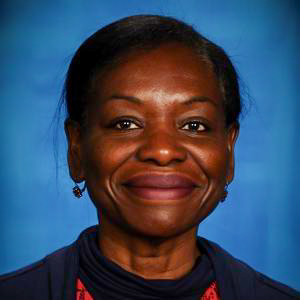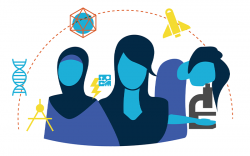Meet Eugenie Farrow – Teacher, Computer Scientist, and Notable Woman in STEM
We recently sat down (virtually) with Eugenie Farrow, a teacher at Spokane Valley Tech, to learn more about her career path and work as a programmer and computer science educator. In addition to teaching high school computer science courses, Eugenie volunteers at Spark Central in their Drop-in and Code program where students in grades 3 to 7 learn problem solving and computer science skills. Read on to learn more about her career path.
Can you explain to us what you do?
I’m a computer science teacher. I help students learn how to solve problems using computers and prepare for college and career. The introductory class is broad and helps students explore the field of computer science to see if it’s something that they’re interested in. The advanced computer science class is focused on programming using Java. This year I started teaching cybersecurity. There are so many opportunities in cybersecurity and lots of real-world stuff to talk about in the class. It’s exciting to think about hackers and things like that, but we’re all at risk for threats and there’s a big market for that skill. So, introducing students to cybersecurity in a high school course is a great opportunity for them. I also volunteer at Spark Central in their Drop-in and Code program where I work with students in grades 3 to 7 on learning to problem solve and have fun with computing.
What was your education and/or career path? How did you get where you are now?

As a high school student, I did not have a clear direction as to what I wanted to do. We were new to this country and my parents were trying to navigate the U.S. while providing for seven children. I knew I was going to college, but not sure what I was going to do there. I went to Santa Clara University for my undergraduate degree and tried several majors: Biology, Psychology, and then Political Science. At one point I thought I was going to go to law school, so I earned a Political Science degree. I feel like technology “found me”.
I started working for IBM as a hardware test equipment buyer. It was my first real exposure to using a computer for work and it excited me. IBM had a shortage of mainframe computer programmers and they asked people to take an aptitude test for a training program to learn programming for mainframe operating systems. I had taken Fortran and liked it, so I applied. I learned to write code specifically for the MVS operating system using Assembler and PL/X and got classified as a junior programmer, eventually becoming an advisory software engineer. During my time at IBM, I completed a master’s degree in business and became a certified project manager.
I started my teacher training program at Eastern Washington University immediately after retiring from IBM. In one of my classes, we had a “get to know you” session and I said that I had been working as a software engineer and the teacher mentioned an opening for a computer science teacher in the Central Valley School District. And so, I applied! That is how I came to my current position. Before teaching computer science in this setting, I learned Java and Python. I’ve continued to learn about other languages, systems and areas related to teaching outside of my regular classroom content.
What/who were some of your most important influences that guided you to STEM?
I had managers at IBM who encouraged and supported my professional development in computing. I was able to take programming courses during the workday through UC Santa Cruz. I had colleagues who worked on early generations of the operating system and were generous with their time and knowledge. They mentored me. My family was also supportive. When I was hired at IBM, my father said he had never seen me so excited about work. When I began the rigorous new programmer training, my husband had to take on a lot of responsibility because I had school demands. I spent many late nights in the computer lab finishing projects.

What is your favorite part of your job?
As a teacher, I enjoy helping students understand how computing relates to our everyday lives. I also enjoy seeing students grasp a concept. It is satisfying to see them apply that concept to a problem they are working on. I learn a lot from my students. Computing is ever-changing and every year I get a different group of students who bring new things in the world of computing to my attention. That’s fun.
What do you consider your biggest achievement in STEM?
I think the length of my career at IBM and transitioning from industry to teaching are achievements. Starting out in IBM’s new programmer training with around 20 trainees and graduating from the program as the only black person was an achievement for me. Also, helping to develop three new patents for IBM’s portfolio. I wrote a chapter in one of IBMs Redbooks (a technical manual for users) and have contributed to other technical documents. I am also proud that I was able to earn a master’s degree. I had three children under ten at the time, so that, to me, is an achievement. I feel like I can’t pick just one.
Are there any stereotypes about women in STEM you’d like to personally dispel?
That women are not as capable. We can do pretty much whatever we set our minds to do. We shouldn’t be judged by gender, the color of our skin, the clothes we wear or anything external. Women have a broad range of interests, capabilities, and experiences. Their voices bring value to STEM.
What unique qualities do you think girls and women bring to STEM?
Having diverse voices and points of view makes products and projects better in terms of value to customers and users in general. It makes for better design outcomes. Women bring that to STEM.
How do you see science, technology, engineering, and/or math working together in your current job?
Science, technology, engineering and math are about solving problems. In my job, that is what I try to focus on. How can we solve this problem using computing? Teaching is also about learning from failures. In my experience, programming solutions never work the first time. It takes multiple tries to get something good.
What would you like to say to young women thinking about beginning a career in STEM?
I would say to go for it. Don’t think this is something that is beyond your reach. Take small steps if you need to. There are people willing to help you be successful. Don’t be afraid to ask. It will take hard work, but it will be worth it. You will make mistakes. Learn from them and move forward.
What do you think is unique about Washington and the STEM careers in our state?
My impression is that Washington has opportunities in many areas for STEM careers. There are businesses of all sizes in Washington, lots of startups. There is an entrepreneurial vibe here and so for STEM, there is much to choose from in terms of industry, size of organization, location, and more.
Can you share a fun fact about yourself?
I love to dance and have taken classes in tap, salsa, and tango. I have tap shoes that I should probably get rid of, but I can’t bring myself to part with them just yet.